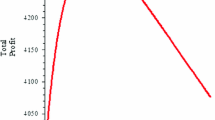Abstract
The demand for a product is influenced by a number of factors, including selling price and displayed stock, among others. Considering this, a novel mathematical model is proposed that takes into account the aforementioned situation where both the selling price and the amount of inventory on hand influence consumer’s demand. Besides that, the supplier grants a full trade credit period to the retailer. This policy is very advantageous for both the counterpart—the seller and the buyer. By offering a delay time, the supplier can entice additional clients, while the retailer has the advantage of receiving items without immediate payment. The suggested inventory model aims at determining the optimal selling price and optimal replenishment cycle length so as to maximize the total profit of the retailer per unit time. The suggested inventory model is also demonstrated numerically, as well as an extensive sensitivity analysis is executed to emphasize the outcomes and offer insightful managerial information. Sensitivity analysis can be helpful in figuring out how different cost factors will affect the overall profit earned.
Access this chapter
Tax calculation will be finalised at checkout
Purchases are for personal use only
Similar content being viewed by others
References
Alfares HK, Ghaithan AM (2016) Inventory and pricing model with price-dependent demand, time-varying holding cost, and quantity discounts. Comput Ind Eng 94:170–177
Cárdenas-Barrón LE, Shaikh AA, Tiwari S, Treviño-Garza G (2020) An EOQ inventory model with nonlinear stock dependent holding cost, nonlinear stock dependent demand and trade credit. Comput Ind Eng 139:105557
Chang CT, Goyal SK, Teng JT (2006) On “An EOQ model for perishable items under stock-dependent selling rate and time-dependent partial backlogging” by Dye and Ouyang. Eur J Oper Res 174(2):923–929
Chang H-C, Ho C-H, Ouyang L-Y, Su C-H (2009) The optimal pricing and ordering policy for an integrated inventory model linked to order quantity. Appl Math Model 33:2978–2991
Cuñat V, Garcia-Appendini E (2012) Trade credit and its role in entrepreneurial finance. Oxford handbook of entrepreneurial finance, 526–557
Datta TK, Pal AK (1990) A note on an inventory model with inventory-level dependent demand rate. J Oper Res Soc 41(10):971–975
Feng L, Chan YL, Cárdenas-Barrón LE (2017) Pricing and lot-sizing polices for perishable goods when the demand depends on selling price, displayed stocks, and expiration date. Int J Prod Econ 185:11–20
Garg P, Chauhan Gonder SS, Singh D (2022) Hybrid crossover operator in genetic algorithm for solving N-queens problem. In: Soft computing: theories and applications, 91–99, Springer, Singapore
Ghosh PK, Manna AK, Dey JK, Kar S (2021) An EOQ model with backordering for perishable items under multiple advanced and delayed payments policies. J Manage Anal https://doi.org/10.1080/23270012.2021.1882348
Goyal SK (1985) Economic order quantity under conditions of permissible delay in payments. J Oper Res Soc 36(4):335–338
Gupta H, Kumar S, Yadav D, Verma OP, Sharma TK, Ahn CW, Lee JH (2021) Data analytics and mathematical modeling for simulating the dynamics of COVID-19 epidemic—a case study of India. Electronics 10(2):127
Haley CW, Higgins HC (1973) Inventory policy and trade credit financing. Manage Sci 20(4):464–471
Hsieh TP, Dye CY (2017) Optimal dynamic pricing for deteriorating items with reference price effects when inventories stimulate demand. Eur J Oper Res 262(1):136–150
Khanna A, Kishore A, Sarkar B, Jaggi CK (2020) Inventory and pricing decisions for imperfect quality items with inspection errors, sales returns, and partial backorders under inflation. RAIRO-Oper Res 54(1):287–306
Khanra S, Mandal B, Sarkar B (2013) An inventory model with time dependent demand and shortages under trade credit policy. Econ Model 35:349–355
Kumar A, Sharma TK, Verma OP, Poonia AS, Bisht M (2022) COVID-19 Cases in India: prediction and analysis using machine learning. In: Soft computing: theories and applications. Springer, Singapore, 551–563
Levin RI, McLaughlin CP, Lamone RP, Kattas JF (1972) Productions/operations management: contemporary policy for managing operating systems. McGraw Hill, New York
Mishra U, Cárdenas-Barrón LE, Tiwari S, Shaikh AA, Treviño-Garza G (2017) An inventory model under price and stock dependent demand for controllable deterioration rate with shortages and preservation technology investment. Ann Oper Res 254(1–2):165–190
Musa A, Sani B (2012) Inventory ordering policies of delayed deteriorating items under permissible delay in payments. Int J Prod Econ 136:75–83
Ouyang L-Y, Ho C-H, Su C-H (2009) An optimization approach for joint pricing and ordering problem in an integrated inventory system with order-size dependent trade credit. Comput Ind Eng 57:920–930
Robinson B, Lakhani C (1975) Dynamic price models for new-product planning. Manage Sci 21(6):1113–1122
Teng JT, Chang CT (2005) Economic production quantity models for deteriorating items with price- and stock-dependent demand. Comput Oper Res 32(2):297–308
Wu KS, Ouyang LY, Yang CT (2006) An optimal replenishment policy for non-instantaneous deteriorating items with stock-dependent demand and partial backlogging. Int J Prod Econ 101(2):369–384
Author information
Authors and Affiliations
Corresponding author
Editor information
Editors and Affiliations
Rights and permissions
Copyright information
© 2023 The Author(s), under exclusive license to Springer Nature Singapore Pte Ltd.
About this paper
Cite this paper
Kumari, M., Narang, P., De, P.K. (2023). Optimization of an Inventory Model with Selling Price and Stock Sensitive Demand Along with Trade Credit Policy. In: Kumar, R., Verma, A.K., Sharma, T.K., Verma, O.P., Sharma, S. (eds) Soft Computing: Theories and Applications. Lecture Notes in Networks and Systems, vol 627. Springer, Singapore. https://doi.org/10.1007/978-981-19-9858-4_5
Download citation
DOI: https://doi.org/10.1007/978-981-19-9858-4_5
Published:
Publisher Name: Springer, Singapore
Print ISBN: 978-981-19-9857-7
Online ISBN: 978-981-19-9858-4
eBook Packages: Intelligent Technologies and RoboticsIntelligent Technologies and Robotics (R0)




